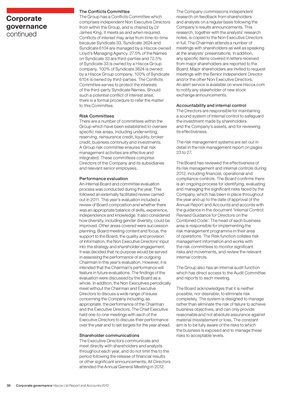
The Conflicts Committee The Company commissions independent
Corporate The Group has a Conflicts Committee which
comprises independent Non Executive Directors
research on feedback from shareholders
and analysts on a regular basis following the
governance from within the Group, and is chaired by Dr Company’s results announcements. This
continued James King. It meets as and when required.
Conflicts of interest may arise from time-to-time
research, together with the analysts’ research
notes, is copied to the Non Executive Directors
because Syndicate 33, Syndicate 3624 and in full. The Chairman attends a number of
Syndicate 6104 are managed by a Hiscox-owned meetings with shareholders as well as speaking
Lloyd’s Managing Agency. 27.5% of the Names at the analysts’ presentations. In addition,
on Syndicate 33 are third-parties and 72.5% any specific items covered in letters received
of Syndicate 33 is owned by a Hiscox Group from major shareholders are reported to the
company. 100% of Syndicate 3624 is owned Board. Major shareholders are invited to request
by a Hiscox Group company. 100% of Syndicate meetings with the Senior Independent Director
6104 is owned by third-parties. The Conflicts and/or the other Non Executive Directors.
Committee serves to protect the interests An alert service is available on www.hiscox.com
of the third-party Syndicate Names. Should to notify any stakeholder of new stock
such a potential conflict of interest arise, exchange announcements.
there is a formal procedure to refer the matter
to this Committee. Accountability and internal control
The Directors are responsible for maintaining
Risk Committees a sound system of internal control to safeguard
There are a number of committees within the the investment made by shareholders
Group which have been established to oversee and the Company’s assets, and for reviewing
specific risk areas, including underwriting, its effectiveness.
reserving, reinsurance credit, liquidity, broker
credit, business continuity and investments. The risk management systems are set out in
A Group risk committee ensures that risk detail in the risk management report on pages
management activities are effective and 23 to 27.
integrated. These committees comprise
Directors of the Company and its subsidiaries The Board has reviewed the effectiveness of
and relevant senior employees. its risk management and internal controls during
2012, including financial, operational and
Performance evaluation compliance controls. The Board confirms there
An internal Board and committee evaluation is an ongoing process for identifying, evaluating
process was conducted during the year. This and managing the significant risks faced by the
followed an externally facilitated review carried Company, which has been in place throughout
out in 2011. This year’s evaluation included a the year and up to the date of approval of the
review of Board composition and whether there Annual Report and Accounts and accords with
was an appropriate balance of skills, experience, the guidance in the document ‘Internal Control:
independence and knowledge. It also considered Revised Guidance for Directors on the
how diversity, including gender diversity, could be Combined Code’. The head of each business
improved. Other areas covered were succession area is responsible for implementing the
planning, Board meeting content and focus, the risk management programme in their area
support to the Board, the quality and provision of operations. The Risk function collates risk
of information, the Non Executive Directors’ input management information and works with
into the strategy and shareholder engagement. the risk committees to monitor significant
It was decided that no purpose would be served risks and movements, and review the relevant
in assessing the performance of an outgoing internal controls.
Chairman in this year’s evaluation. However, it is
intended that the Chairman’s performance will The Group also has an internal audit function
feature in future evaluations. The findings of the which has direct access to the Audit Committee
evaluation were discussed by the Board as a and reports to each meeting.
whole. In addition, the Non Executives periodically
meet without the Chairman and Executive The Board acknowledges that it is neither
Directors to discuss a wide range of issues possible, nor desirable, to eliminate risk
concerning the Company including, as completely. The system is designed to manage
appropriate, the performance of the Chairman rather than eliminate the risk of failure to achieve
and the Executive Directors. The Chief Executive business objectives, and can only provide
held one-to-one meetings with each of the reasonable and not absolute assurance against
Executive Directors to discuss their performance material misstatement or loss. The constant
over the year and to set targets for the year ahead. aim is to be fully aware of the risks to which
the business is exposed and to manage these
Shareholder communications risks to acceptable levels.
The Executive Directors communicate and
meet directly with shareholders and analysts
throughout each year, and do not limit this to the
period following the release of financial results
or other significant announcements. All Directors
attended the Annual General Meeting in 2012.
38 Corporate governance Hiscox Ltd Report and Accounts 2012